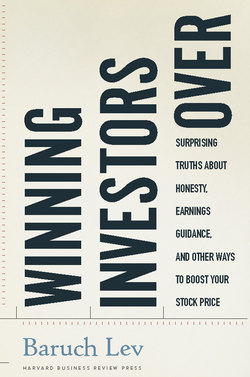Читать книгу Winning Investors Over - Baruch Lev - Страница 28
На сайте Литреса книга снята с продажи.
GAAP to the Rescue, Sort Of
ОглавлениеConsider i2 Technologies, a developer and marketer of supply chain management solutions, which, according to the SEC, “overstated approximately $1.0B of software license revenues” by frontloading sales from 1998 to 2002.10 This enabled i2 to report an increasing revenue stream, portraying itself as a fast-growing company and being rewarded as such by investors. What is front-loading of revenues, you ask? Complex software programs, such as i2’s, usually require significant updating and servicing over an extended time after sale. Recording the total value of the software package, including payments for future services, as revenue at the time of sale is front-loading. But is front-loading a lie? No, if the relevant fact is a finalized software sale, and i2’s front-loading indeed related to finalized sales. However, GAAP—the accounting “law” in the United States—requires the allocation of revenue and income from multiperiod projects over the respective delivery and subsequent service periods (quarters, years) to properly match periodic revenues and expenses. Recording the total revenue of the software in the delivery period and the cost of servicing and updating it in subsequent periods distorts such matching and the consequent income number. Thus, according to GAAP, i2 Technologies’ front-loading of revenues violated truthful reporting and was accordingly sanctioned by the SEC.11 That’s how GAAP substitutes for the missing or hazy facts, in the establishment of truth or falsehood in financial reporting. A GAAP violation is manipulation.
This may seem clear-cut, but nothing in accounting is. There are no clear criteria in GAAP for making reliable estimates, except for the general dictum—use the best information available—which is as helpful as “buy low and sell high.” This is serious, because most financial information items are based on managerial estimates. Not surprisingly, studies have shown that many manipulations of financial information, particularly the “fine tuning” of EPS to beat the consensus analysts’ estimate by a penny or two, are done through “massaging” accounting estimates and projections.12 The upshot is that GAAP is often an insufficient benchmark for investors and regulators to establish truth or trickery in financial reporting, particularly for emerging industries, such as software in the 1980s, biotech in the 1990s, and the Internet services in the 2000s, and for new technologies, such as risk hedging or securitization of intellectual property, where GAAP is lagging considerably behind business developments. For example, in 2002, the FASB started its “revenue recognition” project to update the measurement rules for this key income statement item. As of early 2011 (yes, nine years later), work on this project continues.
GAAP’s inadequacy exposes managers and directors to considerable risk: what may seem truthful reporting to them, the SEC or class-action lawyers might claim later on to be fraudulent.13 AOL is an early case in point. Starting in 1995, the company capitalized, justifiably in my opinion, certain advertising and promotion expenses, claiming that they create an asset—customer franchise—generating future benefits. Trial lawyers and the SEC challenged this practice, which reduced substantially AOL’s reported losses, as manipulative, finally forcing the company in 1998 to reverse the capitalization and write off (charge to expenses) close to $400 million of customer acquisition costs. This early experience with the hazards of intangibles’ capitalization had detrimental effects even when GAAP was clear. The software industry provides an example. GAAP in FASB Statement 87, 1986, calls for the capitalization of software development costs—recognizing them as an asset, rather than an expense—when a project successfully passes the technological feasibility stage. Many software companies, however, particularly the large ones like Microsoft, expense all their software development costs, lest analysts accuse them of earnings manipulation. And yet the evidence shows that software capitalization, when justified, yields earnings that better predict future performance than software expensing.14
Thus, except for clear-cut frauds, such as Parmalat’s claim of having billions of dollars in an empty bank account, or obvious GAAP violations, such as WorldCom’s multibillion-dollar capitalization of regular expenses in the late 1990s, many cases of managed or manipulated information are in a gray area, difficult to ascertain and prosecute. This vagueness poses a serious challenge to managers wishing to make sure that the information they disclose and certify, a Sarbanes-Oxley requirement, is truthful, and to financial information users who rely on the presumed integrity of the information. A thorough analysis of the motives to manipulate financial information and the means of manipulation—both vividly demonstrated by the following cases—goes a long way in drawing a bright line between truth and falsity in financial reporting.
